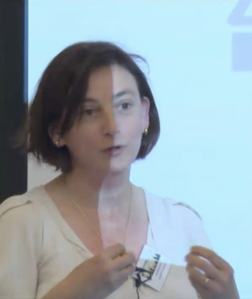
Justin Spinney is lecturer in human geography at the University of Cardiff. In this interview, which we conducted over email, he reflects on his work on mobilities and transport, his application of ethnography in relation to design research and the groups and communities he would like to be able to engage with more through his work.
Tell me briefly about your current or previous research.
The main project I am currently working on is the cross council funded Cycle Boom project. Working across 4 UK cities this project seeks to build up a better picture of cycling in older age with specific reference to the ways in which urban design and new technology (such as e-bikes) can get more older people enjoying cycling. A particular focus for me is ways in which we can understand and measure affect and emotional experience and design environments which promote positive affect rather than simply minimising negative affects.
In addition to this I am also working on a project on HGV design. HGVs are over-represented in collisions with cyclists and pedestrians on European roads, partly because of mass and speed but also because of a design which gives very little direct visibility. I am interested in the effect on drivers of new visual safety technologies – do they for example create ‘sensory overload’ possibly making driving less safe? In addition, I am interested in the passage of new EU safety regulations to modify HGV design, and the ways in which this is being shaped by different stakeholders.
Previous research has looked at the materialities of parenthood, in particular the ways in which objects such as buggies and slings shape the experiences, identities and mobility patterns of new mothers.
Can you identify a group/institution you have not previously worked or collaborated with, but think it might be helpful to do so?
I would very much like to work with car/motorcycle/bicycle manufacturers to look at the possibilities of creating a new kind of ‘bicycle’ which would deviate from the normalised bicycle and encourage more people to cycle who do not currently identify with it for various reasons. Another group who I believe are very important are design students. So to forge partnerships with the RCA, Coventry and Loughborough would also be very productive.
How can we think about mobilities in radical ways?
I believe we need to think through mobility in two inter-related ways. Both of these relate to the ways in which mobility is represented and normalised as this and not that. In much of the Global North we have currently normalised driving because of what it offers us in relation to the ways in which our lives are currently configured. Driving does indeed have many benefits. The challenge is to transfer (through design) the best of these (comfort, care, convenience) to a new breed of ‘vehicle’ whilst leaving the worst (pollution, congestion, harm, sedentarism).
In doing so we are not only attempting to shift the practices of mobility, but also the meanings of mobility. For non (or less-motorised) transport to be successful requires a shift in meanings that is rooted in the alternative practice and representation of mobility. We need positive role models for alternative mobilities rather than the discourses of eccentricity which emerge around new forms of mobility (think Segway and Sinclair C5!).
One of the goals here is to develop more inclusive forms of mobility. Our current vision for cycling in the UK for example currently excludes many people on health, social and cultural grounds. A different approach to design that facilitates new forms of practice and meaning can also engender a more inclusive and equitable politics of mobility.
What are the limits of considering affect in your research field?
Two of the questions I am currently grappling with in the EPSRC Cycle Boom project are how do affects arise and how can we measure them? One of the limitations is how to understand something which has multiple and fleeting influences – it is impossible to isolate ‘variables’ as such so the best we can do is ask participants to relate particular experiences to phenomena. The picture this gives however is far from complete. As a result one of the things we are trying to do is quantitatively measure and map affect using mobile Electroencephalography (EEG) and GIS. This offers up the possibility of bodies ‘speaking for themselves’ and offering less rationalised accounts of emotional and affective experience. However there are also considerable limitations in doing so, not least because the technology we have to measure such experiences whilst mobile is inferior to that available in laboratory settings.
Do you see limitations in the application of ethnography in design research?
I am a big fan of ethnography in design research; I believe if done well it can facilitate a much more grounded understanding of use than (for example) the focus group. In order to do this however requires a great understanding of people’s everyday lives – we cannot look at how people use a particular object in its context of use, rather we need to see how it relates (or doesn’t) to other aspects of life. There are of course limitations. It is time consuming and requires ‘attunement’ of the researcher to the context. It also requires great collaboration between researcher and participant in order to ensure correctness of interpretations.
You use the term ‘destabilisation’…what does it mean and how can this operate in design for collective societal ends?
This relates to my previous point regarding the ways in which norms regarding mobility become sedimented. For example why are ‘cars’ so narrowly conceived as metal boxes with four wheels and a motor? Why are bicycles so narrowly conceived as having two wheels, no motor, no protection from the elements? I believe we need to de-stabilise, upset and over-turn these myopic classifications and find many more hybrids that can break us out of current mobility patterns.
Interview by Leah Armstrong and Guy Julier for ProtoPublics.org


